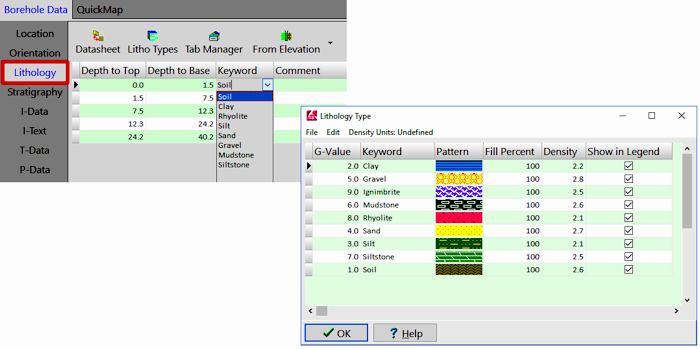 Lithology Types Tables
Lithology Types Tables
The Borehole Manager database uses Lithology data tables for entry of depth intervals and "keywords" that describe the observed rock or soil type for each borehole. These materials can be illustrated in strip logs, and can be interpolated into a solid model for display as blocks, profiles, and more using the program's Lithology menu tools.
The "Lithology Types Table" defines for the program the names of the keywords for the current project's rock/material types, and the graphic pattern / color to use for each in logs and other diagrams. It serves as the reference library for the downhole lithology data. This table is stored in the project database and links to your lithology data.

The Lithology Types Table lists for each rock/soil material:
- The "G" value, which is the numeric value to be used to represent the material in lithology models.
! Use a unique value for each material type.
- The material name, such as "Sand" or "Dolomitic Limestone". This "keyword" field will link to the Lithology data table.
- The pattern and colors to be used to represent the material in diagrams. Double-click on the pattern cell to choose the pattern design, foreground color, and background color.
! Don't use white for all of the pattern backgrounds because the different materials won't show up in 3D models.
- The percent fill for the pattern, which determines how much of the striplog column width the pattern will fill. This is used for striplogs only.
- The material's density, which is used only for volume/mass computations.
- Whether the material is to be displayed in any diagram legends and in the pop-up list linked to the lithology data table.
 Back to Tables summary
Back to Tables summary

RockWare home page

![]() Back to Tables summary
Back to Tables summary